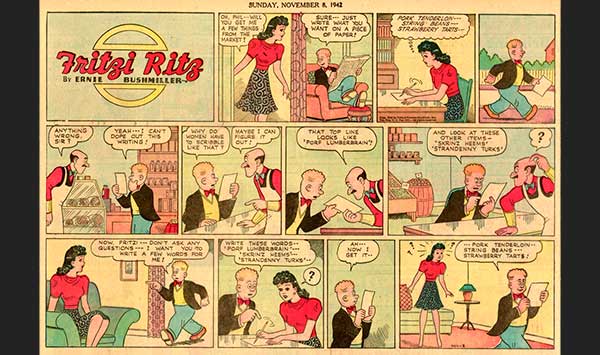Fritzi Ritz was launched in the New York World on Oct. 9, 1922
 After a wonderful and relaxing Christmas with my family, I sat down at my computer to contemplate some possible topics for this week’s column. By chance, I happened to come across a piece that steered me in a completely different direction.
After a wonderful and relaxing Christmas with my family, I sat down at my computer to contemplate some possible topics for this week’s column. By chance, I happened to come across a piece that steered me in a completely different direction.
Fritzi Ritz, the last flapper left in the newspaper funnies, turned 100 on Oct. 9.
This is a name that some people will recognize. Ritz makes occasional appearances in the long-running comic strip Nancy, where the main character is her niece. She’s often seen as the voice of reason when Nancy, Sluggo and their pals get into all sorts of mischief and good-natured fun.
Here’s the interesting thing. The comic strip in which Ritz mostly plays “second fiddle” to Nancy, as D.D. Degg wrote in The Daily Cartoonist, was where she used to perform as first violinist.
 |
| More in Entertainment |
| It’s a streaming service, Charlie Brown
|
| Christmas pantomime a charming holiday tradition
|
| Roadshow movies once provided musical magic
|
Fritzi Ritz was launched in the New York World on Oct. 9, 1922. She was portrayed as part of the flapper movement, in which young women in the Roaring Twenties began to assert their independence by dressing, acting and talking in a manner that was then perceived as unconventional.
“Flapper humour was one of the pop-art signatures of the Jazz Age,” Hogan’s Alley magazine editor Tom Heintjes wrote on Mar. 6, 2013, “and strips showcasing attractive ditzes – notably, written by men working in an industry almost completely bereft of women – were commonplace, from Cliff Sterrett’s Polly and Her Pals to Chic Young’s Dumb Dora (and Blondie, which initially starred a giggly, jiggly, gold-digging flapper) to Edgar Martin’s Boots and Her Buddies to John Held Jr.’s Merely Margy.”
The strip was created by Larry Whittington. His skills “reflected his journeyman-like but undistinguished talent,” Heintjes noted. Indeed, Whittington’s version of Ritz “was rooted firmly in the idioms of the era.” He only drew the strip for three years before leaving the World. While he continued to work as a cartoonist, and launched another flapper-era strip, Mazie the Model, for the New York Mirror between 1925 and 1928, he’s largely been forgotten in the industry.
Ernie Bushmiller, who succeeded Whittington, was the cartoonist who took Fritzi Ritz to new heights. He minimized Ritz’s ditziness and afforded her more intelligence, charm and foresightedness. He transformed her into a successful Hollywood actress after a film director, Mr. Sizzle, accidentally bumped into her car in 1931. He introduced a new cast of characters, including Uncle Zack, love interest Mr. Van Sheek and her boss, Mr. Blobbs, a nice guy and, at times, a notable cheapskate.
And then came Nancy.
Her niece first appeared on Jan. 2, 1933, as an infrequent houseguest in Ritz’s home. The readership grew more fond of her, which increased Nancy’s role and appearances. According to Brian Walker’s The Best of Ernie Bushmiller’s Nancy (1988), Nancy “pushed Fritzi out of the picture” in the latter’s own strip. When the name was officially changed to Nancy on Oct. 23, 1938, it was “merely a formality.” The introduction of her pal, Sluggo, that year established an impressive comic strip duo, and “the two of them together were more than a match for any cartoonist or editor.”
Walker also referenced a conversation between Bushmiller and his old friend and fellow cartoonist Milt Gross. “Your future is with that little girl,” Gross said to him, to which the book’s author replied, “He was right.”
Nancy and Sluggo took over the strip, which became more offbeat and thought-provoking and frequently broke the fourth wall. Ritz continued to appear in Nancy, albeit in a secondary role as a guardian, parent and disciplinarian. Her fun-loving side was maintained in the Sunday strip named after her until it ended on Sept. 24, 1967.
Bushmiller passed away in 1982. The next few cartoonists to take the reins – Mark Lasky for the dailies, Al Plastino on Sundays, and Jerry Scott in both – pushed Ritz further into the background. Guy and Brad Gilchrist brought back her sexualized, flapper-like personality and even had her marry the long-suffering Phil Fumble.
In 2018, Nancy’s reins were taken over by cartoonist Olivia Jaimes (which is a pseudonym). There are noticeable dashes of Bushmiller’s genius in her exceptional work, including the strip’s playful, offbeat nature. Nancy and Sluggo often make philosophical observations about life, which has added a new dimension to their personalities. Jaimes also revised Ritz’s marriage and modernized her character in a manner no one had ever previously attempted. “She seems like someone who can’t believe she’s somehow raising her niece,” Emily St. James wrote in Vox on Dec. 26, 2018, “but making the best of it anyway.”
Ritz is now one of only a few comic strip characters to reach 100. Degg mentioned a short list of luminaries, including The Weatherbird in the St. Louis Post-Dispatch (1901-present), The Katzenjammer Kids (1897-2006) and Gasoline Alley (1918-present).
What will the flapper-cum-feminist do for an encore? Maybe we’ll find out in 2023.
Michael Taube, a Troy Media syndicated columnist and political commentator, was a speechwriter for former Prime Minister Stephen Harper. He holds a master’s degree in comparative politics from the London School of Economics.
For interview requests, click here.
The opinions expressed by our columnists and contributors are theirs alone and do not inherently or expressly reflect the views of our publication.
© Troy Media
Troy Media is an editorial content provider to media outlets and its own hosted community news outlets across Canada.

